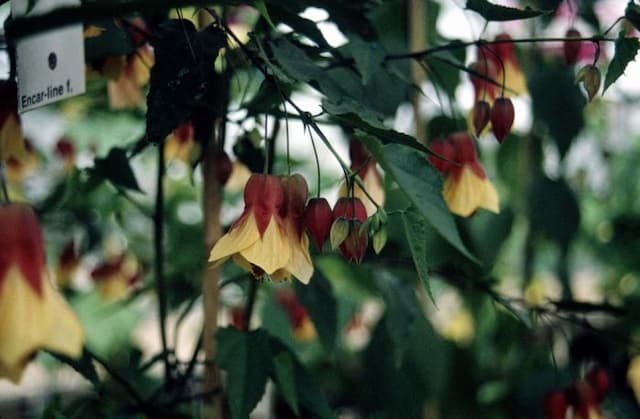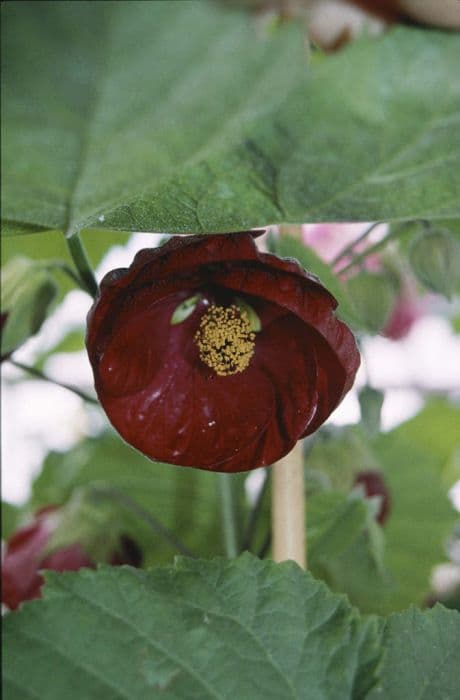Bluebird Hibiscus Hibiscus syriacus 'Oiseau Bleu'

ABOUT
Hibiscus syriacus 'Oiseau Bleu', commonly known as Blue Bird Rose of Sharon, is a deciduous shrub noted for its striking flowers and appealing aesthetic. The plant blooms with large, trumpet-shaped flowers that have a bold blue hue. These flowers showcase a distinct, darker blue throat and a contrasting deep red-purple center, giving them a dramatic and eye-catching appearance. The petals are broad and slightly ruffled, contributing to the flower's overall allure. Surrounding the blooms are lush, pointed leaves that often have a serrated edge, appearing in a bright green color that complements the blue flowers perfectly and adds to the shrub's dense, bushy appearance. The leaves may take on yellow or golden hues before falling off as the seasons change. The plant also exhibits a branching structure that helps to create an attractive, well-rounded shape in the landscape. Blue Bird Rose of Sharon's flowers are not only beautiful but also attract beneficial pollinators such as butterflies and bees, adding dynamism and ecological value to a garden setting. The continuous blooming habit of the plant, from mid-summer to early fall, ensures a long-lasting display of color and interest, making it a popular choice among gardeners and landscapers for creating visual impact.
About this plant
 Names
NamesSynonyms
Blue Bird Rose of Sharon, Blue Satin Althea, Oiseau Bleu Hibiscus.
Common names
Hibiscus syriacus 'Oiseau Bleu'.
 Toxicity
ToxicityTo humans
The Rose of Sharon is generally considered to be non-toxic to humans. There are no significant symptoms of poisoning associated with the plant, as it is not known to contain any toxic compounds that would cause harm if ingested in normal quantities.
To pets
The Rose of Sharon is also generally regarded as non-toxic to pets. It should not cause serious symptoms of poisoning if pets consume parts of the plant. However, as with any plant material, ingestion may sometimes result in mild gastrointestinal upset due to the unusual matter in the pet's digestive system.
 Characteristics
CharacteristicsLife cycle
Perennials
Foliage type
Deciduous
Color of leaves
Green
Flower color
Blue
Height
8 feet (2.4 meters)
Spread
6 feet (1.8 meters)
Plant type
Shrub
Hardiness zones
5
Native area
Asia
Benefits
 General Benefits
General Benefits- Ornamental Value: The Blue Bird Hibiscus offers beautiful, large blue flowers that can enhance the visual appeal of gardens and landscapes.
- Low Maintenance: Once established, it requires minimal care apart from occasional pruning and is relatively drought-tolerant.
- Attracts Wildlife: The vibrant flowers attract pollinators like bees and butterflies, supporting local ecosystems.
- Privacy Screen: With its dense foliage, the Blue Bird Hibiscus can be used as a natural privacy screen or hedge.
- Adaptability: It is adaptable to a variety of soil conditions and can thrive in both full sun and partial shade.
- Seasonal Interest: It has a long blooming period from mid-summer to early autumn, providing color and interest for several months.
- Versatility: The Blue Bird Hibiscus can be used in various landscape designs, including mixed borders, foundation plantings, and as a specimen plant.
- Resistance to Pests: It is known to have good resistance to pests and diseases, reducing the need for chemical treatments.
- Tolerates Urban Pollution: The plant can survive in urban conditions where air quality may be poorer, making it suitable for city gardens.
- Cultural Significance: The Blue Bird Hibiscus is the national flower of South Korea, and it holds cultural importance in various regions.
 Medical Properties
Medical Properties- This plant is not used for medical purposes.
 Air-purifying Qualities
Air-purifying QualitiesThis plant is not specifically known for air purifying qualities.
 Other Uses
Other Uses- Edible Garnishes: The flowers of the Rose of Sharon can be used to add a colorful touch to salads or desserts, as they are safe to eat when grown without harmful chemicals.
- Natural Fabric Dye: The blossoms can be used to create a natural dye for fabrics, imparting a delicate hue to textiles.
- Spiritual Symbolism: In certain cultures, the Rose of Sharon is used in ceremonies as a symbol of beauty and resilience, reflecting its ability to thrive in various conditions.
- Artistic Inspiration: Artists and photographers often use the Rose of Sharon as a subject for their works due to its striking flowers and overall aesthetic appeal.
- Beautification Projects: The Rose of Sharon is planted in public spaces such as parks and along roadways to enhance the visual appeal of these areas.
- Privacy Screening: The dense growth habit of the Rose of Sharon can be used to create natural privacy screens in gardens and yards.
- Pollinator Attraction: Gardeners may plant Rose of Sharon to attract pollinators such as bees, butterflies, and hummingbirds, supporting local ecosystems.
- Aromatherapy: Although not commonly known, the Rose of Sharon's flowers can be used in homemade potpourris to create a subtle, pleasant fragrance in the home.
- Cultural Festivals: In areas where the Rose of Sharon is culturally significant, its flowers may be used during festivals and celebrations as part of traditional decor.
- Craft Projects: The stems and flowers can be incorporated into crafts, such as homemade wreaths or floral arrangements, for a unique and natural look.
Interesting Facts
 Feng Shui
Feng ShuiThe Rose of Sharon is not used in Feng Shui practice.
 Zodiac Sign Compitability
Zodiac Sign CompitabilityThe Rose of Sharon is not used in astrology practice.
 Plant Symbolism
Plant Symbolism- Delicate Beauty: Hibiscus flowers are often associated with delicate beauty due to their intricate and vibrant blossoms.
- Femininity: The soft and graceful appearance of the Rose of Sharon represents feminine qualities and beauty.
- Glory: The Rose of Sharon is mentioned in the Bible, symbolizing glory, and is named after a place believed to be plentiful and fertile.
- Renewal: As the Rose of Sharon blooms annually, it signifies renewal and the cycle of life.
- Unreciprocated Love: In the Victorian language of flowers, hibiscus signifies a delicate beauty or love that is not reciprocated.
 Water
WaterBluebird hibiscus should be watered thoroughly when the top inch of the soil feels dry, which typically means once or twice a week depending on the climate and soil drainage. It is crucial to avoid overwatering as this can lead to root rot. During the growing season, aim to provide about 1 to 1.5 gallons of water per plant for each watering session. In the winter, reduce watering frequency since the plant's growth slows down. Ensure that the plant is in well-draining soil so that water does not accumulate at the roots.
 Light
LightBluebird hibiscus thrives in full sun conditions, requiring at least six hours of direct sunlight each day to bloom prolifically. The plant can tolerate partial shade, especially in the afternoon in hotter climates, but too much shade may reduce flowering and can lead to leggy growth. The ideal spot would be one where the plant receives morning sun and light, partial shade in the late afternoon.
 Temperature
TemperatureThe Bluebird hibiscus prefers a temperature range between 60°F and 90°F for optimal growth. It can survive minimum temperatures down to about 20°F; however, prolonged exposure to freezing temperatures can damage the plant. The plant is more resilient to heat, but consistent temperatures over 90°F might stress it, so some afternoon shade can be beneficial in hotter regions.
 Pruning
PruningPrune Bluebird hibiscus in late winter or early spring to maintain shape and encourage new growth, as well as to remove any dead or damaged branches. It's also advisable to cut back the previous year's growth by about one-third to promote bushier growth and more flowers. Pruning too late in the season can inadvertently remove developing buds, so timing is important.
 Cleaning
CleaningAs needed
 Soil
SoilRose of Sharon thrives in well-draining soil with a slightly acidic to neutral pH of 5.5 to 7.5. A best soil mix can be made of equal parts garden soil, peat moss, and perlite which ensures good drainage and aeration.
 Repotting
RepottingRose of Sharon is typically an outdoor shrub and does not require frequent repotting. In a garden setting, it does not need repotting.
 Humidity & Misting
Humidity & MistingRose of Sharon is tolerant of a wide range of humidity levels and does not require specific humidity conditions to thrive outdoors.
 Suitable locations
Suitable locationsIndoor
Not ideal for indoor; it requires full sun and can grow large.
Outdoor
Plant in full sun, ensure moist, well-draining soil, space adequately.
Hardiness zone
5-9 USDA
 Life cycle
Life cycleThe common name for Hibiscus syriacus 'Oiseau Bleu' is Rose of Sharon. The life cycle of the Rose of Sharon begins with seed germination, which occurs when the seeds are exposed to warm, moist soil conditions in late spring or early summer. The seedlings develop into young plants with characteristic broad leaves, and as they mature, they develop woody stems and a shrub-like form. Flowering typically occurs in the Rose of Sharon from mid-summer to early fall, showcasing the plant's distinctive large, trumpet-shaped flowers that can be blue, purple, pink, or white. After pollination, usually by bees or other insects, the flowers produce seed capsules that mature and release seeds in late fall to early winter, completing the reproductive cycle. The Rose of Sharon can also be propagated vegetatively through cuttings or layering, allowing the plant to skip the seed stage and directly develop new roots and shoots from parts of a mature plant.
 Propogation
PropogationPropogation time
Spring-Early Summer
The most popular method of propagation for the Hibiscus syriacus 'Oiseau Bleu', commonly known as Blue Bird Rose of Sharon, is through softwood cuttings. This typically takes place in late spring to early summer, when new growth is mature enough yet still tender. To propagate, a stem cutting of about 4 to 6 inches (10 to 15 centimeters) is taken from a healthy, disease-free mother plant. The lower leaves are removed, and the cut end may be dipped in rooting hormone to encourage root development. The cutting is then placed in a well-draining potting mix and kept moist and warm. Higher humidity can be maintained around the cutting by covering it with a plastic bag or placing it in a propagator. Roots usually develop within several weeks, after which the new plant can be gradually acclimatized to less humid conditions before being transplanted outdoors.









